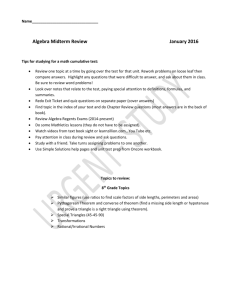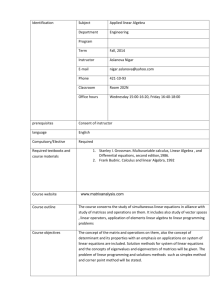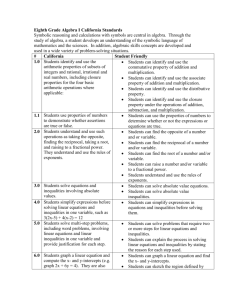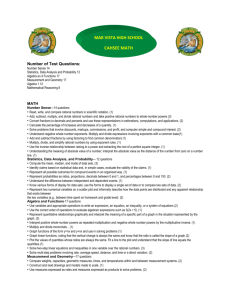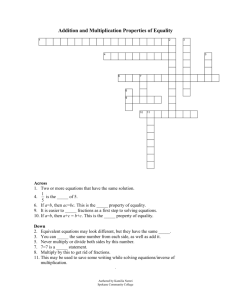Course: Intermediate Algebra
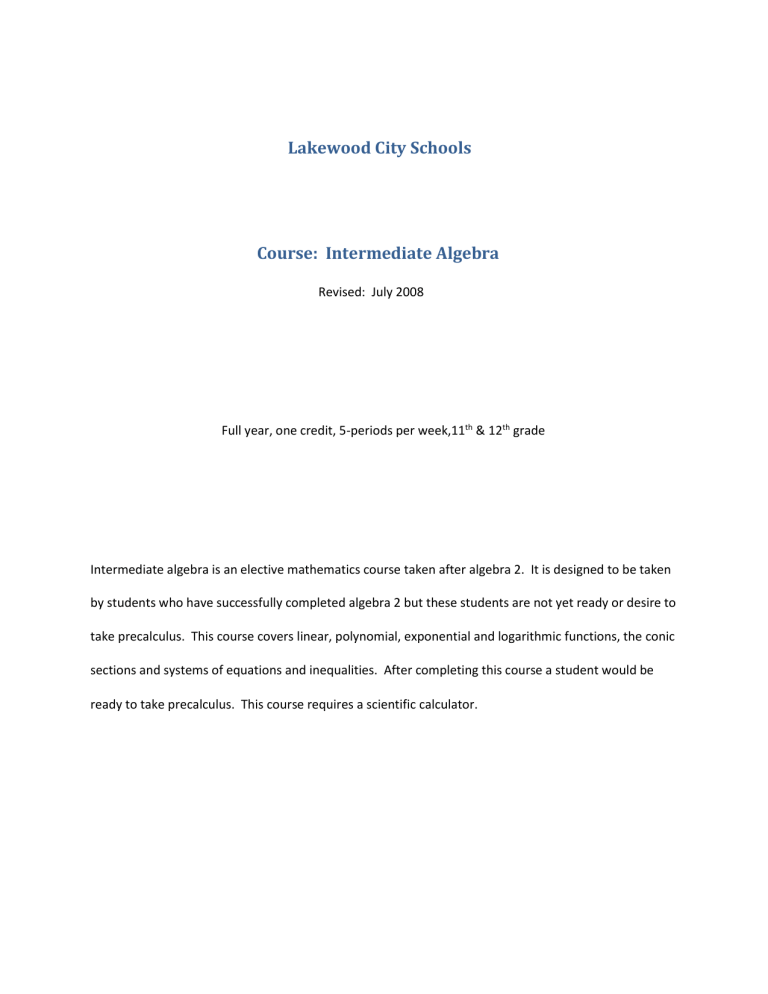
Lakewood City Schools
Course: Intermediate Algebra
Revised: July 2008
Full year, one credit, 5-periods per week,11 th & 12 th grade
Intermediate algebra is an elective mathematics course taken after algebra 2. It is designed to be taken by students who have successfully completed algebra 2 but these students are not yet ready or desire to take precalculus. This course covers linear, polynomial, exponential and logarithmic functions, the conic sections and systems of equations and inequalities. After completing this course a student would be ready to take precalculus. This course requires a scientific calculator.
Lakewood City Schools
Course: Intermediate Algebra
Revised: July 2008
Pacing Chart
First quarter:
Chapter 1-Review of Real Numbers [1-1 to 1-4]
Chapter 2-First Degree Equations and Inequalities [2-1 to 2-6]
Chapter 3-Linear Functions and Inequalities in Two Variables [3-1 to 3-7]
Second quarter:
Chapter 4-Systems of Equations and Inequalities [4-1 to 4-5]
Chapter 5-Polynomials and Exponents [5-1 to 5-7]
Chapter 6-Rational Expressions [6-1 to 6-3]
Third quarter:
Chapter 6-Rational Expressions [6-4 to 6-5]
Chapter 7-Rational Exponents and Radicals [7-1 to 7-5]
Chapter8-Quadratic Equations and Inequalities [8-1 to 8-7]
Fourth quarter:
Chapter 9-Functions and Relations [9-1 to 9-4]
Chapter 10 –Exponential and Logarithmic Functions [10-1 to 10-5]
Chapter 12 –Conic Sections [12-1 to 12-5]
Currently all teacher resources will refer to the book-Intermediate Algebra with Applications by Richard
Aufmann, Vernon Barker, and Joanne Lockwood (copyright 2004, unless otherwise noted. The recommended scientific calculator is the TI-36.
Data Analysis Grade 11
11-12 Benchmark Grade Level Indicator Teacher Resources
3-1 A. Create and analyze tabular and graphical displays of data using appropriate tools, including spreadsheets
11D4 Create a scatterplot of bivariate data, identify trends, and find a function to model the data and graphing calculators 11D5 Use technology to find the
Least Squares Regression Line, the regression coefficient, and the correlation coefficient for bivariate data with a linear trend, and interpret each of these statistics in the context of the problem situation
11D7 Describe the standard normal curve and its general properties, and answer questions dealing with data assured to be
B. Use descriptive statistics to analyze and summarize data, including measures of center, dispersion, correlation and variability normal
11D8 Analyze and interpret univariate and bivariate data to identify patterns, note trends, draw conclusions and make predications
11D10 Understand and use the concept of random variable and compute and interpret the expected value for a random variable in simple cases
11D3 Describe how a linear transformation of univariate data affects range, mean, mode, and median
11D5 Use technology to find the
Least Squares Regression Line, the regression coefficient, and
C. Design and perform a statistical experiment, simulation or study; collect and interpret data; and use descriptive statistics to communicate and support predications and conclusions
D. Connect statistical techniques to applications and consumer situations the correlation coefficient for bivariate data with a linear trend, and interpret each of these statistics in the context of the problem situation
11D6 Use technology to compute the standard deviation for a set of data and interpret standard deviation in relation to the context or problem situation
11D8 Analyze and interpret univariate and bivariate data to identify patterns, note trends, draw conclusions, and make predictions
11D1 Design a statistical experiment, survey or study for a problem; collect data for the problem; interpret data with appropriate graphical displays, descriptive statistics, concepts of variability, causation, correlation and standard deviation
11D2 Describe the role of randomization in a well-designed study, especially as compared to a convenience sample, and the generalization of results from each
11D9 Evaluate validity of results of a study based on characteristics of the study design, including sampling method, summary statistics and data analysis techniques
11D1 Design a statistical experiment, survey or study for a problem; collect data for the problem; interpret data with appropriate graphical displays, descriptive statistics, concepts of variability, causation, correlation
and standard deviation
11D2 Describe the role of randomization in a well-designed study, especially as compared to a convenience sample, and the generalization of results from each
11D9 Evaluate validity of results of a study based on characteristics of the study design, including sampling method, summary statistics and data analysis techniques
11D11 Examine statements and decisions involving risk; e.g., insurance rates and medical decisions
Geometry and Spatial Sense Grade 11
11-12 Benchmark Grade Level Indicator
A. Use trigonometric relationships to verify and determine solutions in problem situations
B. Represent transformations within a coordinate system using vectors and matrices
11G4 Use trigonometric relationships to determine lengths and angle measures
Teacher Resources
11G1 Use polar coordinates to specify locations on a plane
11G2 Represent translations using vectors
11G3 Describe multiplication of a vector and a scalar graphically and algebraically and apply to problem situations
Measurement Grade 11
11-12 Benchmark Grade Level Indicator
A. Explain differences among accuracy , precision and error, and describe how each of those can affect solutions in measurement situations
11M1 Determine the number of significant digits in a measurement
B. Apply various measurement scales to describe phenomena and solve problems
C. Estimate and compute areas and volume in increasingly complex problem situations
11M2 Use radian and degree measures to solve problems and perform conversions as needed
11M3 Derive a formula for the surface area of a cone as a function of its slant height and the circumference of its base
11M4 Calculate distances, areas, surface areas and volumes of composite threedimensional objects to a specified number of significant digits
D. Solve problem situations involving derived measurements
11M5 Solve real-world problems involving area, surface area, volume and density to a specified degree of precision
Teacher Resources
1-4
2-5,3-1,5-3,5-7,8-4
Number, Number Sense and Operations Grade 11
11-12 Benchmark Grade Level Indicator Teacher Resources
A. Demonstrate that vectors and matrices are systems having some of the same properties of the real number system
11N1 Determine what properties hold for matrix addition and matrix multiplication; e.g., use examples to show addition is commutative and when multiplication is not commutative
11N2 Determine what properties hold for vector addition and multiplication, and for scalar multiplication
4-3
4-3 B. Develop an understanding of properties of representations for addition and multiplication of vectors and matrices
C. Apply factorials and exponents, including fractional exponents, to solve practical problems
D. Demonstrate fluency in operations with real numbers, vectors and matrices, using mental computation or paper and pencil calculations for simple cases and technology for more complicated cases
11N1 Determine what properties hold for matrix addition and matrix multiplication; e.g., use examples to show addition is commutative and when multiplication is not commutative
11N2 Determine what properties hold for vector addition and multiplication, and for scalar multiplication
11N5 Model, using the coordinate plane, vector addition and scalar multiplication
11N8 Use fractional and negative exponents as optional ways of representing and finding solutions for problem situations
11N4 Use matrices to represent given information in a problem situation
11N6 Compute sums, differences, and products and quotients of matrices using paper and pencil calculations for simple cases and technology for more complicated cases
11N9 Use vector addition and scalar multiplication to solve problems
5-1,7-1,10-1
4-3
E. Represent and compute with complex numbers
11N3 Represent complex numbers in the complex plane
11N7 Compute sums, differences, products and quotients of complex numbers
7-5
Patterns Functions and Algebra Grade 11
11-12 Benchmark Grade Level Indicator
A. Analyze functions by investigating rates of change, intercepts, zeros, asymptotes and local and global behavior
11P3 Describe and compare the characteristics of the following families of functions: quadratics with complex roots, polynomials of any degree, logarithms, and rational functions; e.g, general shape, number of roots, domain and range, asymptote behavior
11P4 Identify the maximum and minimum points of a polynomial, rational and trigonometric functions graphically and
B. Use the quadratic formula to solve quadratic equations that have complex roots with technology
11P5 Identify families of functions with graphs that have rotation symmetry or reflection symmetry about the y-axis, xaxis or y = x
11P6 Represent the inverse of a function symbolically and graphically as a reflection about y=x
11P10 Describe the characteristics of the graphs of conic sections
11P11 Describe how a change in the value of a constant in an exponential, logarithmic or radical equation affects the graph of the equation
11P8 Solve equations involving radical expressions and complex roots
Teacher Resources
5-2,6-1,8-6,8-7,9-1,9-2,10-
1,10-3
5-2,6-1,9-1
9-4
12-1,12-2,12-3,12-4
7-3,9-1,10-1,10-3
7-4,8-1,8-2,8-3,8-4,
C. Use recursive functions to model and solve problems
11P1 Identify and describe problem situations involving an iterative process that can be represented as a recursive formula; e.g., compound interest
11P2 Translate a recursive function into a closed form expression or formula for the nth term to solve a problem situation involving an iterative process
10-5
D. Apply algebraic methods to represent and generalize problem situations involving vectors and matrices
11P7 Model and solve problems with matrices
11P9 Solve 3x3 systems of linear equations by elimination and using technology and interpret graphically what the solution means
4-3
4-2
Patterns, Functions and Algebra
8-10 Benchmark
A. Generalize and explain patterns and sequences in order to find the next term and the n th term.
B. Identify and classify functions as linear or nonlinear, and contrast their properties using tables, graphs or equations.
C. Translate information from one representation
(words, table, graph or equation) to another representation of a relation or function.
Grade Level Indicator
Define function formally and with f(x) notation
Teacher Resources
3-2
Solve equations and formulas for a specified variable; e.g., express the base of a triangle in terms of the area and height.
3-3, 6-6
Use algebraic representations and functions to describe and generalize geometric properties and relationships
2-1,2-2,2-3,2-4,3-3
D. Use algebraic representations, such as tables, graphs, expressions, functions and inequalities, to model and solve problem situations.
Solve real-world problems that can be modeled using linear, quadratic, exponential or square root functions
3-1,3-3,3-5,5-1,5-3,5-7,6-4,7-4,8-
4,10-5
E. Analyze and compare functions and their graphs using attributes, such as rates of change, intercepts and zeros.
F. Solve and graph linear equations and inequalities
Describe and compare characteristics of the following families of functions: square root, cubic, absolute value and basic trigonometric functions; e.g., general shape, possible number of roots, domain and range.
2-1,2-6,5-2,5-6,7-1,8-1,9-1
Solve simple linear and nonlinear equations and inequalities having square roots as coefficients and solutions.
Solve equations and inequalities having rational expressions as coefficients and solutions.
2-1,2-5,6-4,8-1,8-2
G. Solve quadratic equations with real roots by graphing, formula and factoring.
Graph the quadratic relationship that defines circles.
8-1,8-2,8-3,8-4,8-5,8-6,8-7
Solve systems of linear inequalities. 4-1,4-2,4-3,4-4,4-5 H. Solve systems of linear equations involving two variables graphically and symbolically.
I. Model and solve problem situations involving direct and inverse variation.
J. Describe and interpret rates of change from graphical and numerical data.
Solve real-world problems that can be modeled, using systems of linear equations and inequalities
2-1,2-4,2-5,6-5
Describe the relationship between slope of a line through the origin and the tangent function of the angle created by the line and the positive x -axis.
3-4,3-6
